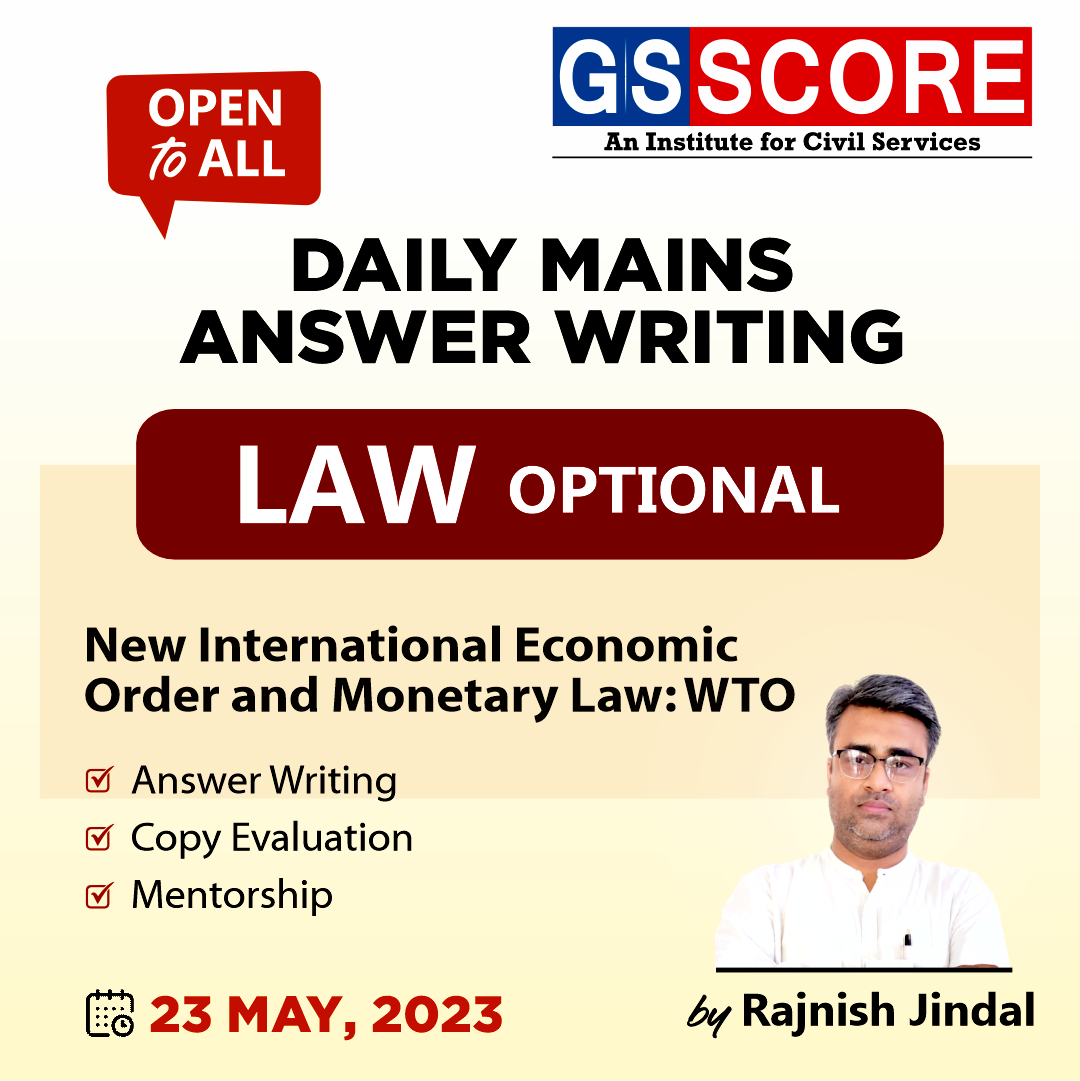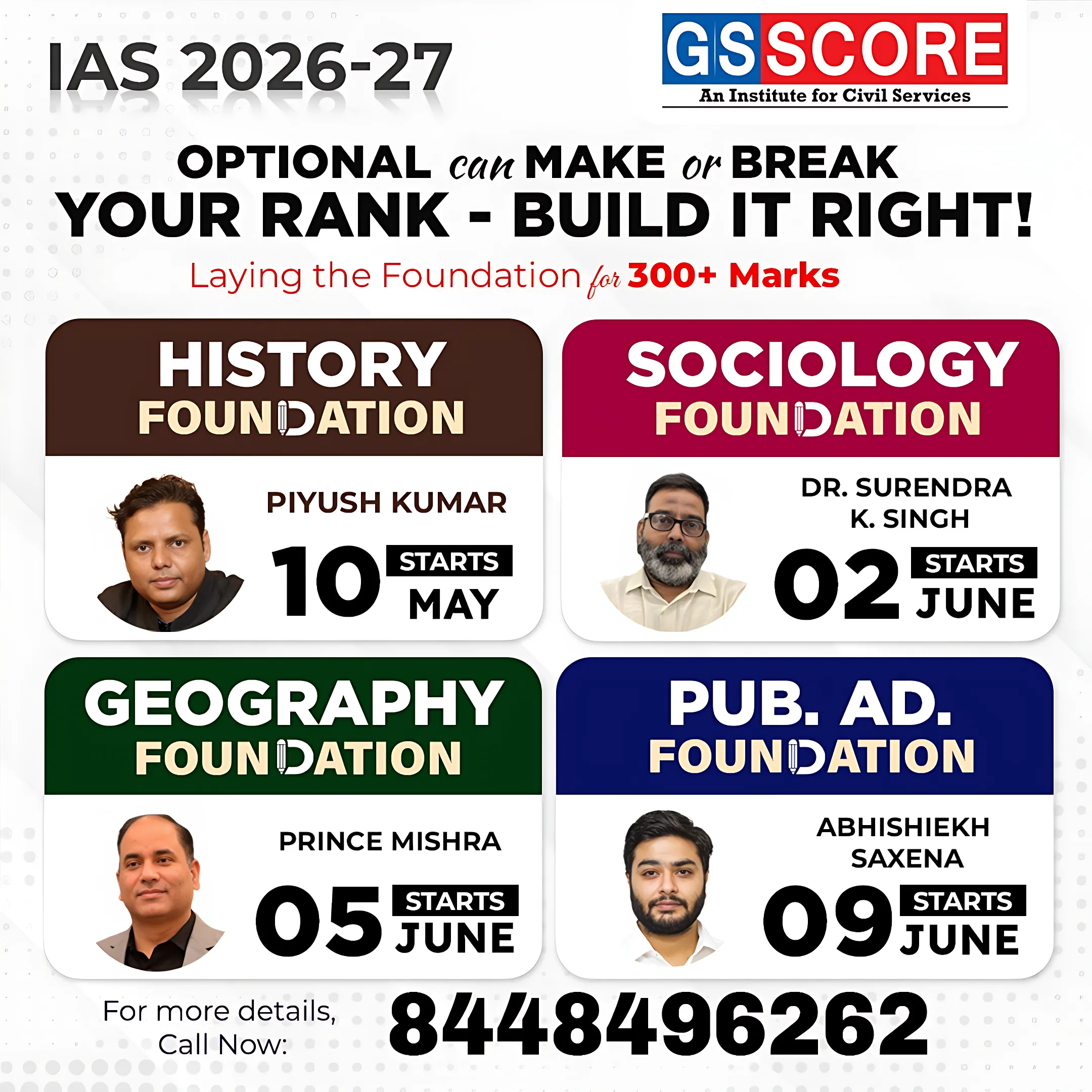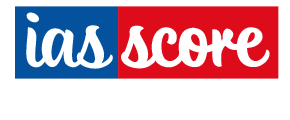


Instruction:
- There will be 2 questions carrying 10 marks each. Write your answers in 150 words
- Any page left blank in the answer-book must be crossed out clearly.
- Evaluated Copy will be re-uploaded on the same thread after 2 days of uploading the copy.
- Discussion of the question and one to one answer improvement session of evaluated copies will be conducted through Google Meet with concerned faculty. You will be informed via mail or SMS for the discussion.
Question #1. Critically evaluate the WTO dispute settlement mechanism and standard of review in the dispute settlement.
Question #2. “The inability of the World Trade Organization (WTO) to rein in global trade tensions has raised questions about its relevance in today’s world.” Examine.
(Examiner will pay special attention to the candidate's grasp of his/her material, its relevance to the subject chosen, and to his/ her ability to think constructively and to present his/her ideas concisely, logically and effectively).
STEPS & INSTRUCTIONS for uploading the answers
Step 1 - The Question for the day is provided below these instructions. It will be available at 7:00 AM.
Step 2 - Uploading of Answers : Write the answer in A4 Sheet leaving proper margins for comments and feedback and upload the PDF in MY ACCOUNT section. Click on the option of SUBMIT COPY to upload the PDF.
Step 3 - Deadline for Uploading Answers: The students shall upload their answers by 7:00 PM in the evening same day. The first 50 copies will be evaluated.
Step 4 - Feedback : Mentors will give their feedback for the answers uploaded. For more personalised feedback, join our telegram channel by clicking on the link https://t.me/mains_answer_writing_cse . A one-to-one session will be conducted with the faculty after copy evaluation in 72 Hrs.
Model Answer
Question #1. Critically evaluate the WTO dispute settlement mechanism and standard of review in the dispute settlement.
Ans. Disputes in the WTO are essentially about broken promises. WTO members have agreed that if they believe fellow-members are violating trade rules, they will use the multilateral system of settling disputes instead of taking action unilaterally. That means abiding by the agreed procedures, and respecting judgements.
A dispute arises when one country adopts a trade policy measure or takes some action that one or more fellow-WTO members considers to be breaking the WTO agreements, or to be a failure to live up to obligations. A third group of countries can declare that they have an interest in the case and enjoy some rights.
A procedure for settling disputes existed under the old GATT, but it had no fixed timetables, rulings were easier to block, and many cases dragged on for a long time inconclusively. The Uruguay Round agreement introduced a more structured process with more clearly defined stages in the procedure. It introduced greater discipline for the length of time a case should take to be settled, with flexible deadlines set in various stages of the procedure. The agreement emphasizes that prompt settlement is essential if the WTO is to function effectively. It sets out in considerable detail the procedures and the timetable to be followed in resolving disputes. If a case runs its full course to a first ruling, it should not normally take more than about one year — 15 months if the case is appealed. The agreed time limits are flexible, and if the case is considered urgent (e.g. if perishable goods are involved), it is accelerated as much as possible.
The Uruguay Round agreement also made it impossible for the country losing a case to block the adoption of the ruling. Under the previous GATT procedure, rulings could only be adopted by consensus, meaning that a single objection could block the ruling. Now, rulings are automatically adopted unless there is a consensus to reject a ruling — any country wanting to block a ruling has to persuade all other WTO members (including its adversary in the case) to share its view.
Although much of the procedure does resemble a court or tribunal, the preferred solution is for the countries concerned to discuss their problems and settle the dispute by themselves. The first stage is therefore consultations between the governments concerned, and even when the case has progressed to other stages, consultation and mediation are still always possible.
|
These approximate periods for each stage of a dispute settlement procedure are target figures — the agreement is flexible. In addition, the countries can settle their dispute themselves at any stage. Totals are also approximate. |
|
|
60 days |
Consultations, mediation, etc |
|
45 days |
Panel set up and panellists appointed |
|
6 months |
Final panel report to parties |
|
3 weeks |
Final panel report to WTO members |
|
60 days |
Dispute Settlement Body adopts report (if no appeal) |
|
Total = 1 year |
(without appeal) |
|
60-90 days |
Appeals report |
|
30 days |
Dispute Settlement Body adopts appeals report |
|
Total = 1y 3m |
(with appeal) |
If the courts find themselves handling an increasing number of criminal cases, does that mean law and order is breaking down? Not necessarily. Sometimes it means that people have more faith in the courts and the rule of law. They are turning to the courts instead of taking the law into their own hands.
For the most part, that is what is happening in the WTO. No one likes to see countries quarrel. But if there are going to be trade disputes anyway, it is healthier that the cases are handled according to internationally agreed rules. There are strong grounds for arguing that the increasing number of disputes is simply the result of expanding world trade and the stricter rules negotiated in the Uruguay Round; and that the fact that more are coming to the WTO reflects a growing faith in the system.
How are disputes settled?
Settling disputes is the responsibility of the Dispute Settlement Body (the General Council in another guise), which consists of all WTO members. The Dispute Settlement Body has the sole authority to establish “panels” of experts to consider the case, and to accept or reject the panels’ findings or the results of an appeal. It monitors the implementation of the rulings and recommendations, and has the power to authorize retaliation when a country does not comply with a ruling.
First stage: consultation (up to 60 days). Before taking any other actions the countries in dispute have to talk to each other to see if they can settle their differences by themselves. If that fails, they can also ask the WTO director-general to mediate or try to help in any other way.
Second stage: the panel (up to 45 days for a panel to be appointed, plus 6 months for the panel to conclude). If consultations fail, the complaining country can ask for a panel to be appointed. The country “in the dock” can block the creation of a panel once, but when the Dispute Settlement Body meets for a second time, the appointment can no longer be blocked (unless there is a consensus against appointing the panel).
Officially, the panel is helping the Dispute Settlement Body make rulings or recommendations. But because the panel’s report can only be rejected by consensus in the Dispute Settlement Body, its conclusions are difficult to overturn. The panel’s findings have to be based on the agreements cited.
The panel’s final report should normally be given to the parties to the dispute within six months. In cases of urgency, including those concerning perishable goods, the deadline is shortened to three months.
The agreement describes in some detail how the panels are to work. The main stages are:
- Before the first hearing: each side in the dispute presents its case in writing to the panel.
- First hearing: the case for the complaining country and defence: the complaining country (or countries), the responding country, and those that have announced they have an interest in the dispute, make their case at the panel’s first hearing.
- Rebuttals: the countries involved submit written rebuttals and present oral arguments at the panel’s second meeting.
- Experts: if one side raises scientific or other technical matters, the panel may consult experts or appoint an expert review group to prepare an advisory report.
- First draft: the panel submits the descriptive (factual and argument) sections of its report to the two sides, giving them two weeks to comment. This report does not include findings and conclusions.
- Interim report: The panel then submits an interim report, including its findings and conclusions, to the two sides, giving them one week to ask for a review.
- Review: The period of review must not exceed two weeks. During that time, the panel may hold additional meetings with the two sides.
- Final report: A final report is submitted to the two sides and three weeks later, it is circulated to all WTO members. If the panel decides that the disputed trade measure does break a WTO agreement or an obligation, it recommends that the measure be made to conform with WTO rules. The panel may suggest how this could be done.
- The report becomes a ruling: The report becomes the Dispute Settlement Body’s ruling or recommendation within 60 days unless a consensus rejects it. Both sides can appeal the report (and in some cases both sides do).
PANELS: Panels are like tribunals. But unlike in a normal tribunal, the panellists are usually chosen in consultation with the countries in dispute. Only if the two sides cannot agree does the WTO director-general appoint them.
Panels consist of three (possibly five) experts from different countries who examine the evidence and decide who is right and who is wrong. The panel’s report is passed to the Dispute Settlement Body, which can only reject the report by consensus.
Panelists for each case may be chosen from an indicative list of well-qualified candidates nominated by WTO Members, although others may be considered as well, including those who have formerly served as panelist. Panelists serve in their individual capacities. They cannot receive instructions from any government. The indicative list is maintained by the Secretariat and periodically revised according to any modifications or additions submitted by Members.
Appeals: Either side can appeal a panel’s ruling. Sometimes both sides do so. Appeals have to be based on points of law such as legal interpretation — they cannot reexamine existing evidence or examine new issues.
Each appeal is heard by three members of a permanent seven-member Appellate Body set up by the Dispute Settlement Body and broadly representing the range of WTO membership. Members of the Appellate Body have four-year terms. They have to be individuals with recognized standing in the field of law and international trade, not affiliated with any government.
The appeal can uphold, modify or reverse the panel’s legal findings and conclusions. Normally appeals should not last more than 60 days, with an absolute maximum of 90 days.
The Dispute Settlement Body has to accept or reject the appeals report within 30 days — and rejection is only possible by consensus.
Conclusion: The system has both strengthens and weaknesses. For example, with respect to its weaknesses, despite the deadlines, a full dispute settlement procedure still takes a considerable amount of time, during which the complainant suffers continued economic harm if the challenged measure is indeed (WTO)-inconsistent. No provisional measures (interim relief) are available to protect the economic and trade interests of the successful complainant during the dispute settlement procedure. Moreover, even after prevailing in dispute settlement, a successful complainant will receive no compensation for the harm suffered during the time given to the respondent to implement the ruling. Nor does the “winning party” receive any reimbursement from the other side for its legal expenses. In the event of non-implementation, not all Members have the same practical ability to resort to the suspension of obligations. Lastly, in a few cases, a suspension of concessions has been ineffective in bringing about implementation. However, these cases are the exception rather than the rule.
How successful one considers the dispute settlement system to have been depends on the benchmark one applies. If one compares the WTO dispute settlement system with the previous dispute settlement system of GATT 1947, the current system has been far more effective. Moreover, its quasi-judicial and quasi-automatic character enables it to handle more difficult cases. These features also provide greater guarantees for Members that wish to defend their rights. Compared with other multilateral systems of dispute resolution in international law, the compulsory nature and the enforcement mechanism of the WTO dispute settlement system certainly stand out.
Question #2. “The inability of the World Trade Organization (WTO) to rein in global trade tensions has raised questions about its relevance in today’s world.” Examine.
Ans. The World Trade Organization (WTO) is the principal forum for setting the rules of international trade. In its two and a half decades, it has helped reduce barriers to trade in both goods and services and created a dispute resolution system that supporters say reduced the threat of trade wars.
However, the institution is under considerable pressure. Negotiations on a comprehensive development agenda have foundered due to disagreements over agricultural subsidies and intellectual property rights, while members have increasingly turned to separate bilateral and regional free trade agreements to advance their trade interests. More recently, the COVID-19 pandemic caused a sharp decline in international trade and has driven uncertainty about the future of global supply chains.
Former U.S. President Donald Trump criticized the WTO for what he saw as its weakness in confronting China’s trade abuses and constraints on U.S. sovereignty. His administration intentionally crippled the organization’s appeals body, ensuring that its decisions cannot be enforced and placing the future of global trade rules into doubt. President Joe Biden’s administration has emphasized the U.S. commitment to the organization but has largely continued its predecessor’s approach.
Criticisms of the organization vary. Farmers and labor groups accuse the WTO of focusing too narrowly on corporate interests, environmentalists worry about deregulation, and U.S. policymakers allege that the institution has failed to handle Chinese abuses. The primary concerns include:
Intellectual property. The WTO’s intellectual property agreement, Trade-Related Aspects of Intellectual Property Rights (TRIPS), draws criticism from experts who have argued that WTO rules on drug patents have limited access to medicines in poorer countries. The WTO says that enforcing patent protections is central to expanding global trade. A group of emerging economies, led by India and South Africa, have proposed a TRIPS waiver for COVID-19 vaccines and treatments, but the move is opposed by some wealthier countries.
Sovereignty and regulation. Other critics say WTO rules overrule national sovereignty, and in doing so erode environmental and labor protections. Environmental groups have criticized WTO decisions on genetically modified foods, as well as recent rulings against what the WTO considers discriminatory environmental labeling, as in the case of U.S. dolphin-safe labeling. Labor unions in the United States argue that the WTO is inadequate for protecting U.S. wages from being undercut by unfair labor practices abroad, alleging, for instance, that China violates basic workers’ rights to lower the cost of its exports. Developing countries counter that attempts to address labor standards at the WTO are a form of protectionism in disguise.
Import competition. Some economists argue that by promoting imports and encouraging firms to move their operations abroad, WTO-led tariff reductions hurt U.S. jobs and wages. The Economic Policy Institute’s Robert E. Scott and Will Kimball estimated in 2014 that China’s entrance into the WTO in 2001 led to the loss of more than three million U.S. jobs, as U.S. firms were forced to compete with China’s much cheaper imports. Other estimates find [PDF] a smaller but still substantial loss of around two million jobs, though some experts contend that technological changes, not China, were responsible for those losses. Trade proponents including Dartmouth College economist Douglas Irwin say that increased trade with China benefited the U.S. economy by lowering prices, increasing productivity, and expanding exports. Some analysts claim that most of the consumer benefits that came with China’s accession went to poor and middle-class Americans.
Response to China. Trump was a vociferous critic of Chinese state-led development policy, arguing that while the United States has adhered to global trade rules, other countries—primarily China—have gained an advantage by ignoring them. CFR’s Alden says that Washington and its allies “did too little for too long,” failing to confront China’s abuses at the WTO. Biden has largely maintained his predecessor’s approach to Beijing on trade, including the use of unilateral tariffs. CFR’s Hillman and Alex Tippett write that the Biden administration’s “hesitance to embrace a role for the WTO in addressing some of its concerns with China could fatally compromise the organization.”
Many experts say that a renewed U.S. commitment to the organization is critical to restoring the WTO’s standing. In the end, the WTO would not have been created, and cannot move forward, without U.S. leadership.


